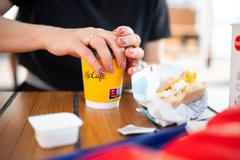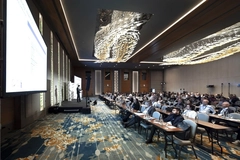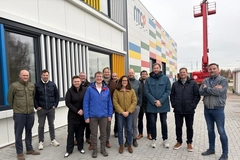Caps and closures shift from plastic to hybrid and fiber in circularity push

Caps and closures are undergoing a transformative material shift away from conventional plastic. Manufacturers are innovating to harness the sustainability merits of bioplastics, fiber, and hybrid solutions.
Closures are at the intersection of material design change and shifting regulatory and consumer demands. To gain deeper insight into the caps and closures landscape, Packaging Insights speaks to Great Earth and Blue Ocean Closures about how the industry is moving away from plastic solutions and embracing hybrid or fiber-based solutions.
Patrik Falk, CEO of Great Earth, highlights three converging trends in the caps and closures industry: heightened consumer expectations for sustainable products, regulatory frameworks like the EU’s Single-Use Plastics Directive, and the integration of ESG metrics into corporate performance indicators.
To target these trends, Falk tells us that companies are pursuing parallel paths. “The first involves optimizing existing plastic systems through lightweighting initiatives, reducing material usage by 20–30% while maintaining structural integrity, and transitioning to monomaterial designs.”
“The second path explores alternative materials entirely. Beyond traditional plastics, manufacturers are investigating fiber-based solutions, bio-polymers derived from agricultural waste, and hybrid constructions that minimize fossil-based content.”
Falk argues that EU EPR legislation creates financial incentives for sustainable choices, accelerating the shift toward circular design principles.
Ulrika Evermark, chief communication and relations officer at Blue Ocean Closures, highlights a “strong drive” from packaging manufacturers to reduce carbon footprint using fiber-based solutions.
“Brands within several consumer goods segments see fiber-based closures as a way to future-proof their packaging portfolio, recognizing that the solution can fit different kinds of bottles and containers.”
Rethinking perceptions
Falk says consumers often misunderstand materials deemed sustainable or circular, thinking in binary terms of “good” or “bad” for the environment.
 Great Earth’s fiber-based screw caps cut plastic by 95% (Image credit: Great Earth).He explains that the binary overlooks hybrid solutions, which can “reduce plastic content by 95% while maintaining full functionality.”
Great Earth’s fiber-based screw caps cut plastic by 95% (Image credit: Great Earth).He explains that the binary overlooks hybrid solutions, which can “reduce plastic content by 95% while maintaining full functionality.”
“We’ve achieved this with our fiber-based caps, delivering immediate environmental benefits while technology continues advancing toward complete alternatives.”
Falk challenges industry assumptions that consumers reject sustainable options, citing a recent study that revealed that nine out of ten participants selected products with fiber-based closures when asked to identify the most environmentally friendly packaging design.
Meanwhile, Evermark highlights a common misconception that fiber-based solutions are more expensive, cannot be produced to scale, and have limited performance qualities compared to plastic.
She adds: “As they are made of a natural material such as cellulosic fibers to maximize recyclability and biodegradability, another misconception is that bio-based closures cannot be used for packing beverages or liquids. Blue Ocean Closures has developed several ways of protecting the material and filled goods for packaging structures interacting with water.”
Ensuring cost competitiveness
Creating circular caps and closures comes with challenges around production and material choice.
Evermark says: “The fiber-based closures by Blue Ocean Closures are made of a cellulosic material that is abundant and available in large-scale volumes with consistent properties. The proprietary vacuum press forming technology to produce closures is a dry, highly energy-efficient way of achieving advanced shapes at a high speed.”
 Blue Ocean Closures is scaling fiber-based technology to deliver recyclable caps at high volume (Image credit: Blue Ocean Closures).She explains the technology is easy to scale, adding that this is an important quality as, to compete with plastics, sustainable caps and closures must meet the high volume demand at a cost-competitive level.
Blue Ocean Closures is scaling fiber-based technology to deliver recyclable caps at high volume (Image credit: Blue Ocean Closures).She explains the technology is easy to scale, adding that this is an important quality as, to compete with plastics, sustainable caps and closures must meet the high volume demand at a cost-competitive level.
Falk notes that sustainable materials are more expensive than virgin plastics. “Manufacturers face a challenging equation: absorb higher costs, pass them to consumers, or wait for competitors to move first. EPR fees are beginning to shift this calculus, but the transition period creates significant financial pressure.”
Although it’s clear that consumers state a preference for sustainable choices, says Falk, consumer behavior can contradict intentions. “We as producers cannot give the consumer anything less convenient than the current solution. Anything that is seen as an inconvenience will be rejected.”
Material and infrastructure challenges
Falk also points to technical challenges involving moisture barriers, chemical resistance, mechanical strength, and moldability.
“Alternative materials often excel in some areas while failing in others. Fiber-based solutions, for instance, require specialized coatings to achieve moisture resistance, potentially compromising recyclability.”
He also mentions child-resistant mechanisms, which can be complex when using non-conventional materials.
Falk notes that infrastructure gaps, economic realities, and market acceptance are other challenging areas.
“Even perfectly designed circular closures fail without supporting infrastructure. Collection and sorting systems vary dramatically between regions. What works in Sweden’s advanced recycling ecosystem may be landfilled elsewhere.”
A business necessity
 Great Earth says its hybrid caps balance sustainability and convenience without sacrificing performance (Image credit: Great Earth).Evermark predicts fiber-based closure use to increase in the future. This applies to single-use items, FMCGs like nutraceuticals or drinks, and reusable packaging.
Great Earth says its hybrid caps balance sustainability and convenience without sacrificing performance (Image credit: Great Earth).Evermark predicts fiber-based closure use to increase in the future. This applies to single-use items, FMCGs like nutraceuticals or drinks, and reusable packaging.
She explains: “The beverage carton industry and brands within dairy, for example, have stated that fiber-based closures are the way forward, and we expect to see some impactful changes in this segment. The liquid board packaging segment alone constitutes some 135 billion closures produced and consumed annually.”
Falk outlines three “transformative” trends that will shape the caps and closures industry in the future. In the immediate future, Falk says, the industry will see the integration of “smart closures” that incorporate technologies like QR codes, NFC tags, and RFID into caps.
“This will unlock a new dimension of functionality, enabling everything from granular supply chain traceability to combat counterfeiting, to delivering rich, interactive brand experiences directly to a consumer’s smartphone.”
Other developments anticipated by Falk include material science innovation and EU regulation standardization, such as tethered cap legislation.
He concludes: “Companies that invest in modular, separable closure systems will gain competitive advantages. Future designs will feature functional components (sealing mechanisms, tamper-evident features) that separate easily from decorative elements, enabling efficient recycling and product customization.”
“With expanding EPR schemes worldwide, sustainable closure design will shift from a market differentiator to a business necessity.”











